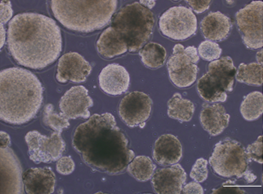Result and Discussion

Figure 1. 3D cultured hESC-derived hepatocytes
Figure 1 shows the hESC-derived hepatocytes that were cultured in a three-dimensional environment.
After maturation, we tested glycogen storage and cholesterol absorption ability, which is the basic function of hepatocytes.

Figure 2. (a) PAS staining (purple: glycogen, dark purple: nucleus) (b) 24 hours after treatin immunostained LDL (LDL: orange)
Figure 2 describes the ability of glycogen storage and cholesterol absorption of hESC-derived hepatocytes.
As we can see in the figure, hESC-derived hepatocytes are able to store glycogen and absorb cholesterol.
These results prove the successful differentiation of hESCs into hepatocytes.

Figure 3. Result of qPCR
Figure 3 shows a result of qPCR. The expression level was normalized by the gene expression of the control.
As shown in the figure, there was no superior chemical that vastly enhances all gene expression.
Instead, each chemical only enhanced specific gene expression.
Table 3 summarizes the order of chemicals according to the gene expression level.

Table 3. Order of chemicals according to gene expression level.

Figure 4. The result of Albumin western blot
Albumin western blot was conducted to verify whether the modified gene expression affected protein expression.
Figure 4 is the result of Albumin western blot.
In the experiment, we normalized the Albumin expression with actin expression to obtain albumin expression per cell.
Generally, albumin expression increased when the ALB gene expression increased.
However, RG108 showed a reversed result. Albumin expression decreased when the RG108 gene expression increased. This indicates that the gene expression level does not necessarily accord with protein expression level.






